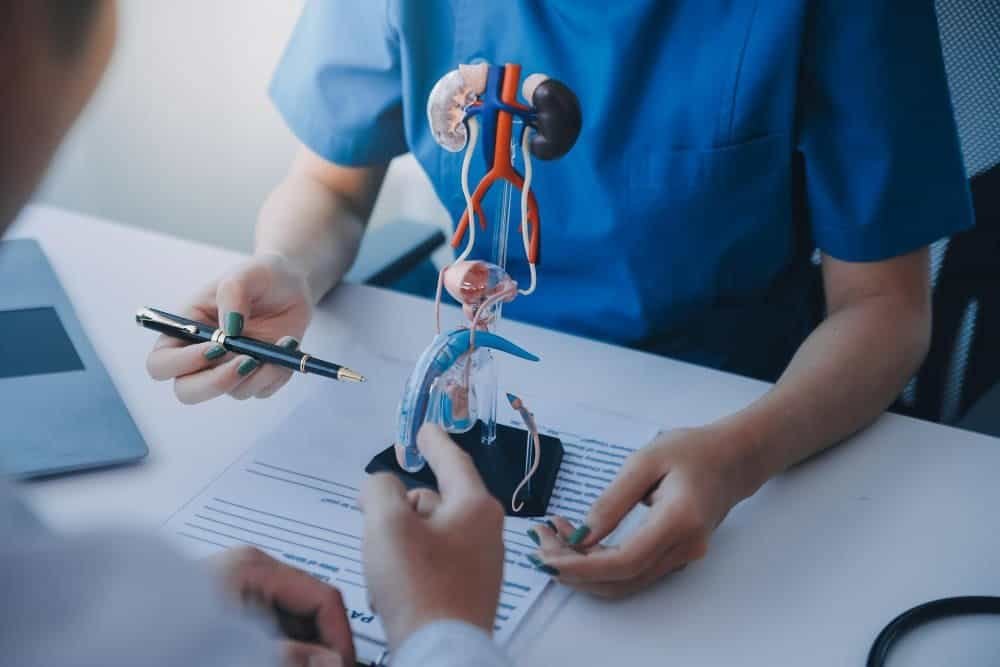Are urinary problems from an enlarged prostate impacting your life? Lasting relief can be found with prostatic artery embolization, a modern, minimally invasive solution that helps you avoid major surgery.
What is Prostatic Artery Embolization (PAE)?
Prostatic artery embolization, often abbreviated as PAE, is an advanced, minimally invasive procedure designed to treat the troublesome urinary symptoms caused by an enlarged prostate. This condition is medically known as benign prostatic hyperplasia (BPH) or benign prostatic hypertrophia.
Unlike traditional surgical options, PAE is a nonsurgical technique that offers significant relief by addressing the root cause of the enlargement in a targeted way. The treatment is performed by a specialized doctor known as an Interventional Radiologist.
The core idea behind prostate artery embolisation is simple yet effective. It consists of reducing the blood supply to the prostate gland. The prostate is a small gland in men that can grow larger with age, leading to BPH.
This growth is fueled by blood delivered through the prostatic arteries. By limiting this blood flow, the procedure helps the prostate to shrink in size, thereby easing the pressure on the urethra and improving the flow of urine. This innovative approach is a game-changer for many people dealing with moderate to severe lower urinary tract symptoms who are seeking an alternative to conventional surgery.
Understanding Benign Prostatic Hyperplasia (BPH)
Before diving deeper into the specifics of the PAE procedure, it’s important to understand the condition it is designed to treat. Benign prostatic hyperplasia is a non-cancerous enlargement of the prostate gland that affects a vast number of men, particularly as they get older. The prostate surrounds the urethra, the tube that carries urine out of the body. As the gland enlarges, it squeezes the urethra, leading to a host of uncomfortable and disruptive urinary symptoms.
These lower urinary tract symptoms can significantly impact a person’s quality of life and may include:
- A frequent or urgent need to urinate.
- Increased urination at night (nocturia).
- Difficulty starting urination.
- A weak or interrupted urine stream.
- The inability to completely empty the bladder.
These symptoms are caused directly by the physical obstruction from the enlarged prostate. For years, the primary treatments involved medication, which can have side effects, or surgical procedures like transurethral resection of the prostate (TURP), which involves removing prostate tissue but comes with risks and a longer recovery period. Prostatic artery embolization emerged as a powerful alternative, offering a less invasive path to relief for many.
How the PAE Procedure is Performed
The elegance of prostatic artery embolization lies in its precision and minimally invasive nature. The entire procedure is guided by advanced imaging technology, allowing the Interventional Radiologist to work with incredible accuracy without making large incisions. Here is a step-by-step overview of how the treatment is achieved:
An Interventional Radiologist, a physician with expertise in using medical imaging to perform targeted treatments, begins by making a tiny puncture, usually in the wrist or groin, to access an artery.
A very thin tube called a microcatheter is then carefully guided through the body’s network of blood vessels using real-time X-ray guidance. The goal is to target the specific prostatic arteries that are supplying blood to the prostate gland. These are the small vessels that feed the enlarged tissue. 🎯
Once the catheter is perfectly positioned in the arteries supplying the prostate, the embolization part of the procedure begins. This consists of injecting microscopic small particles, often described as tiny plastic beads, into these blood vessels.
These particles travel down the artery and create a blockage. The process is then repeated for the artery on the other side of the prostate. This technique effectively blocks the targeted vessels, significantly reducing blood flow to the gland. The entire procedure is performed with the patient awake but sedated, ensuring comfort throughout the process.
The Outcome: Shrinking the Prostate and Improving Flow
The primary goal of blocking the blood supply is to initiate a process of shrinking within the prostate gland. Deprived of the rich blood flow that fuels its growth, the prostate tissue begins to soften and decrease in size over the following weeks and months. This reduction in size is the key to alleviating the troublesome lower urinary tract symptoms associated with BPH.
As the prostate shrinks, it eases the compression on the urethra. This helps create a wider channel, allowing urine to flow more freely and forcefully. Patients typically notice a significant improvement in their urinary symptoms over time.
The benefits include a stronger stream, less frequent trips to the bathroom (especially at night 😴), and a greater sense of bladder emptying. The effectiveness of PAE in shrinking the prostate and improving symptoms has made it a leading nonsurgical option for BPH treatment. The blood vessels are not permanently damaged, but the flow is strategically blocked to achieve the desired therapeutic effect.
Who is an Ideal Candidate for Prostatic Artery Embolization?
Prostatic artery embolisation is a highly effective treatment, but it is not suitable for everyone. A thorough evaluation by an experienced Interventional Radiologist, such as Dr. Samir Abdel Ghaffar, is necessary to determine if a patient is a good candidate. Generally, PAE is recommended for people who:
- Have moderate to severe lower urinary tract symptoms caused by benign prostatic hyperplasia.
- Have not found sufficient relief with medications or have experienced undesirable side effects from them.
- Wish to avoid traditional surgical options due to the associated risks, such as bleeding, infection, and sexual side effects.
- May not be good candidates for surgery due to other health conditions.
The specialist will use advanced imaging techniques, such as an MRI or CT scan, to assess the size and shape of the prostate as well as the anatomy of the prostatic arteries. This detailed mapping ensures that the Interventional Radiologist can effectively target the correct blood vessels during the procedure. This careful selection process is crucial for achieving the best possible outcomes. 👍
PAE vs. Traditional Surgery: A Modern Advantage

When considering treatment for an enlarged prostate, many men are faced with a choice between a traditional surgical technique and a modern, minimally invasive procedure like PAE. Understanding the differences is key to making an informed decision.
Prostatic Artery Embolization (PAE):
- Minimally Invasive: Involves only a small puncture in the skin, not large incisions.
- Lower Risk of Major Complications: PAE has a significantly lower risk of major bleeding and sexual side effects, such as erectile dysfunction or retrograde ejaculation.
- Faster Recovery: Most patients can go home the same day and return to normal activities within a few days. ⏳
- Local Anesthesia: The procedure is typically performed under local anesthesia with sedation, avoiding the risks of general anesthesia.
Traditional Surgery (e.g., TURP):
- Invasive: Requires cutting and removing prostate tissue, which can lead to more significant bleeding.
- Higher Risk of Side Effects: Carries a well-documented risk of sexual side effects and urinary incontinence.
- Longer Recovery: Usually requires a hospital stay of one or two days and a recovery period of several weeks.
- General or Spinal Anesthesia: Necessitates a more intensive form of anesthesia.
For many people, the advantages of Prostate Artery Embolisation make it a highly attractive option. It offers a path to relief from BPH symptoms without the extended downtime and potential complications of a major surgical operation.
The Crucial Role of the Interventional Radiologist
The success of a prostatic artery embolization procedure is highly dependent on the skill and experience of the physician performing it. An Interventional Radiologist is a board-certified physician who specializes in using advanced imaging like X-ray and ultrasound to perform minimally invasive treatments throughout the body. Their expertise lies in navigating the intricate network of blood vessels to deliver targeted therapies precisely where they are needed.
An experienced Interventional Radiologist like Dr. Samir Abdel Ghaffar has undergone extensive training to master these complex techniques. They are adept at reading sophisticated imaging to map out the prostatic arteries, which can vary in location from person to person.
This ability to accurately target the arteries that feed the prostate gland while avoiding other nearby vessels is what makes the treatment both safe and effective. Choosing a qualified specialist is the most important step in exploring PAE as a solution for your BPH symptoms. ✅
A New Era of Prostate Treatment
Prostatic artery embolization represents a significant step forward in the management of benign prostatic hyperplasia. It is part of a growing field of interventional radiology that offers less invasive but highly effective solutions for conditions that once required open surgery. By blocking the small blood vessels supplying the prostate, this technique leverages the body’s natural processes to shrink the gland and restore normal urinary function.
If you are tired of your life being dictated by troublesome urinary symptoms, it may be time to consider a modern solution. A consultation with an expert in interventional radiology can help you understand if PAE is the right choice for you, offering a path toward lasting relief and an improved quality of life. ✨
 العربية
العربية 

